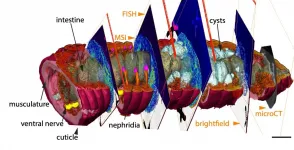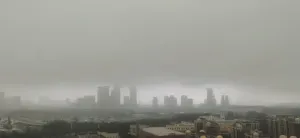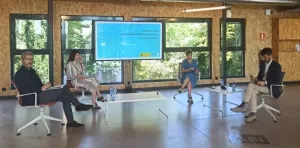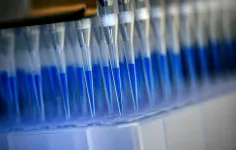The earthworm in new light
New method to visualize anatomical structures including the products of an earthworm's metabolism
2021-06-29
(Press-News.org) Earthworms experience constant chemical interactions with bacteria, fungi, plants and small invertebrates across soil ecosystems. Even within their tissues, earthworms harbor symbiotic microbes and small animal parasites that trigger internal metabolic responses such as innate immunity. To reveal the fundamental processes that enable animal-microbe symbioses to form and persist, we have to study their metabolic interactions in situ. By combining novel imaging techniques, a team of researchers around Benedikt Geier from the Max Planck Institute for Marine Microbiology (MPIMM) in Bremen, Germany, has now succeeded in imaging the exciting variety of interactions that take place inside the earthworm. This allows us to observe them in a completely new light.
The chemistry of the worm in 3D
Our understanding of the chemical interactions between small animals and the microorganisms that live inside their bodies is extremely limited. This gap of knowledge has its origin in a methodical challenge: To study the metabolic interactions in symbiosis we have to know who is producing which metabolic product where in the body. The core of this problem, however, is not only to image how molecules are distributed at the micrometer scale. Also, the chemical images are almost impossible to interpret without knowing if a tissue sample is healthy, diseased or infected with beneficial or pathogenic microbes or even animal parasites.
The new combination of high-resolution imaging techniques can offer a solution to this problem, as the research team now shows. "In our study, we introduce chemo-histo-tomography, a special three-dimensional imaging approach of the chemistry and anatomy of millimeter-sized animals and their parasites at a cellular level," says Benedikt Geier, first author of the paper. "This method offers a new strategy to visualize the most fundamental processes - metabolic interactions - in small animal symbioses. It allows us to spatially assign metabolic producs to the animal host and its microbial partners at the micrometer scale."
Chemo-histo-tomography (CHEMHIST) combines chemical imaging of metabolites based on MALDI mass spectrometry imaging with the microanatomy of the same animal that is recorded with micro-computed X-ray tomography. The latter is a non-invasive approach allowing X-ray imaging of the 3D histology, and can reach subcellular resolution. For metabolite imaging, MALDI mass spectrometry techniques have become a state-of-the-art tool to visualize micrometer-scale, natural distributions of metabolites. This enables a spatial assignment between chemical profiles and their production site and possibly to their producer.
"This advance allowed us to take an earthworm from the environment and create a 3D atlas of its chemical and physical interactions with the microorganisms naturally occurring inside its tissues," says Manuel Liebeke, leader of the Research Group Metabolic Interactions at the MPIMM and senior author of the study. "However, we were interested in more than just the biology of the earthworm. Our objective was to also make CHEMHIST applicable to animals directly sampled from their natural habitat, which can be essential for symbiosis research." The resolution of CHEMHIST outperforms existing similar methods developed for medical research in mice by up to two orders of magnitude. This may also lead into new avenues for research on insects or corals, which are key models for symbiosis research, both on land and in water.
The whole is more than the sum of the parts
Using the combination of different in situ imaging techniques through CHEMHIST, the researchers at the MPIMM in Bremen uncovered metabolites - products of the metabolism - in the earthworm that could shed light on how it chemically defends itself against parasites and how these, in turn, protect themselves against the earthworm's immune response. However, to even recognize that the chemical image data were metabolites of parasites in earthworm tissue, the 3D anatomical model was indispensable. A high-resolution micro-computer tomograph at the German Electron Synchrotron in Hamburg first made it possible to identify the parasites in the tissue.
Notably, metabolic interactions between animals and their microbes are not restricted to symbiotic tissues. Along the gut-brain axis, microbial metabolites produced in the gut can affect tissues across the host, even reaching the brain. Therefore, extending correlative chemical imaging into 3D approaches can be crucial for capturing the distribution of metabolites involved in symbiotic interactions and thus show how chemical signals from microbes possibly affect crucial processes in their host. Also, the method can be used in many ways: The research team around Liebeke and Geier is currently applying it to deep-sea mussels.
"Since I have specialized in the 3D visualization of invertebrate anatomy for years, it was particularly interesting for me to see the molecules hidden behind the morphological structures," says Bernhard Ruthensteiner, leader of the section Invertebrate Varia at the Bavarian State Collection of Zoology. The results of the study were made possible by an interdisciplinary collaboration that brought together scientists from the fields of microbiology, zoology, chemistry and physics. It quickly became clear that visualization such as the correlative 3D atlas of the worm facilitate science communication of the data.
INFORMATION:
[Attachments] See images for this press release:

ELSE PRESS RELEASES FROM THIS DATE:
2021-06-29
Skoltech researchers and their colleagues from Russia and the UK investigated the safety and efficacy of new chemistry in antisense oligonucleotides used to treat spinal muscular atrophy (SMA), a debilitating genetic disease. Their results may lead to the development of drugs with less toxicity and fewer injections needed thanks to prolonged action. The paper was published in the journal Nucleic Acid Therapeutics.
Antisense oligonucleotides are single stranded chemically modified fragments of DNA that target pre-messenger RNA, short bits of genetic information a ribosome reads to make a protein. Depending on how a particular antisense oligonucleotide works, the target mRNA can either be destroyed or undergo subtle changes in how it's spliced, i.e. how exons, the ...
2021-06-29
Russian scientists have experimentally proved the existence of a new type of quasiparticle - previously unknown excitations of coupled pairs of photons in qubit chains. This discovery could be a step towards disorder-robust quantum metamaterials. The study was published in Physical Review B.
Superconducting qubits are a leading qubit modality today that is currently being pursued by industry and academia for quantum computing applications. However, the performance of quantum computers is largely affected by decoherence that contributes to a qubits extremely short lifespan and causes computational errors. Another ...
2021-06-29
Pioneering research has revealed the erosion of ancient sediments found deep beneath Antarctic ice could be a vital and previously unknown source of nutrients and energy for abundant microbial life.
The study, led by the University of Bristol and published today in Nature's Communications Earth & Environment journal, sheds new light on the many compounds supporting various microbes which form part of a huge subglacial ecosystem.
Lead author Dr Beatriz Gill Olivas, a Post-Doctoral Research Associate at the University of Bristol, said: "Although the study focused on samples obtained from a single ...
2021-06-29
During summer 2020, the Yangtze River basin experienced persistent, record-breaking meiyu rainfall. Likewise, the region suffered from severe flooding and water damage as accumulated rainfall broke records dating back to 1954. Regions outside the meiyu rain belt received significant summer rainfall as well, including Beijing, located in northeastern China.
Typically, an above average meiyu rainfall season follows a strong El Niño during the previous winter. However, summer 2020 followed a neutral El Niño-Southern Oscillation (ENSO) event. Therefore, scientists are working ...
2021-06-29
A stimulating environment keeps the "hippocampus" - which is the brain's memory control center - young, so to speak. Causes of this are molecular mechanisms that affect gene regulation. These current findings from studies in mice provide clues as to why an active, varied life can help preserve mental fitness in old age. Researchers from the DZNE and the Center for Regenerative Therapies Dresden (CRTD) at the Technische Universität Dresden report on this in the journal Nature Communications.
Human DNA - and this also applies to mice - contains thousands of genes. However, it is not only the genetic blueprint that is decisive for the function of a cell and whether it is healthy or not, but above all which genes can be switched on or off. ...
2021-06-29
FECYT - Spanish Foundation for Science and Technology - presented today at the headquarters of the National Museum of Science and Technology, MUNCYT, IN Alcobendas, the results of the third Social Perception Survey of scientific aspects of the COVID-19 in a debate moderated by Pampa García Molina, Editor-in-Chief of the SINC Agency, in which Raquel Yotti, Director of the Carlos III Health Institute of Madrid, Josep Lobera, Professor of Sociology at the Universidad Autónoma de Madrid (UAM) and scientific director of the Social Perception Survey on the scientific aspects of COVID-19 and ...
2021-06-29
Polymers are long, chain-like molecules which are everywhere in biology. DNA and RNA are polymers formed by many consecutive copies of nucleotides coupled together. When being transported within or between cells, these biological polymers must pass through nanometre-sized holes called "nanopores".
This process also underlies a rapidly developing method for analysing and sequencing DNA called nanopore sensing.
The study, published in the journal END ...
2021-06-29
Researchers at the University of Leicester have developed a new method to recycle electric vehicle batteries using a ground-breaking new approach that many will have experienced in the dentist's chair.
The Faraday Institution project on the recycling of lithium-ion batteries (ReLiB) led by Professor Andy Abbott at the University of Leicester used a new method, involving ultrasonic waves, to solve a critical challenge: how to separate out valuable materials from electrodes so that the materials can be fully recovered from batteries at the end of their life.
Current recycling ...
2021-06-29
A new corona test developed at the University Hospital Bonn can analyze a large number of swabs simultaneously using sequencing technology and has a similarly high sensitivity as the common qPCR test. The innovative method offers great potential, especially for systematic testing in daycare centers, schools or companies. Today, the results of the study on the new Corona test have been published in the renowned journal "Nature Biotechnology".
Bonn, 6/29/2021 - In addition to vaccination, systematic testing of the population remains of central importance in order to effectively monitor and contain the spread of infections during the Coronavirus pandemic. Only in this way can the spread of the virus be effectively monitored and ...
2021-06-29
Crystallization is one of the most fundamental processes found in nature - and it's what gives minerals, gems, metals, and even proteins their structure.
In the past couple of decades, scientists have tried to uncover how natural crystals self-assemble and grow - and their pioneering work has led to some exciting new technologies - from the quantum dots behind colorful QLED TV displays, to peptoids, a protein-mimic that has inspired dozens of biotech breakthroughs.
Now, a research team led by scientists at the Department of Energy's Lawrence Berkeley National Laboratory (Berkeley Lab) and UC Berkeley has developed a nanoparticle composite that grows ...
LAST 30 PRESS RELEASES:
[Press-News.org] The earthworm in new light
New method to visualize anatomical structures including the products of an earthworm's metabolism








